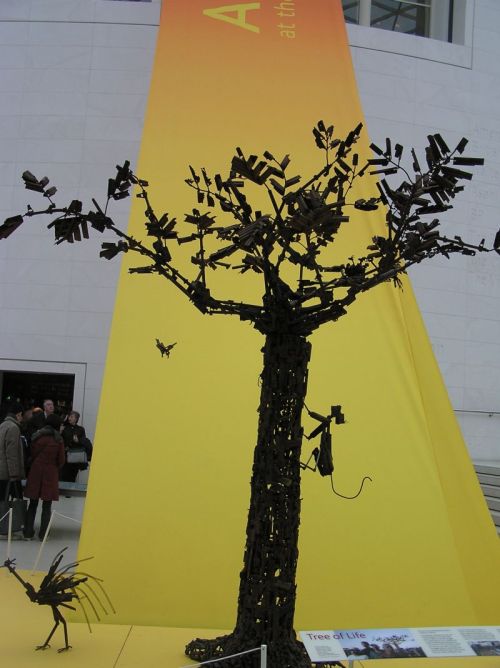Tuesday, 29 March 2011
Floral Patterns Around the House
Thinking back to the Flora and Fauna project, I was surprised by just how many flora patterns I could find. These four came from just two small rooms.
I've just been going through some snaps from my camera for the last few months. More will be uploaded soon, including a few textile pieces from Pallant House Gallery.
Sunday, 6 March 2011
The Tree of Life
On to my next project; this time looking at the concept of the Tree of Life. The Tree of Life, or World Tree, is a basic concept that appears in many cultures throughout history. In Chinese mythology the tree's branches support a phoenix and a dragon and represents immortality. In the Near East, from the Bronze Age onwards, the tree was a religious symbol that was so common in art that the early Greeks copied it in their own art.
Image from Wikipedia
In Judaism and Christianity, the Tree of Life is the tree that bears the fruit that gives knowledge of good and evil in the Garden of Eden, while in the Jewish esoteric tradition of Kabalah, the "Tree of Life" is a mystic symbol that plots the path to HaShem (God)
Image from Wikipedia
In Christianity, the tree of life is also used in imagery of the crucifixion, and as with Chinese mythology it's a symbol of rebirth.
Image from "Godzdogz" blog
The Tree also appears in Mesoamerican religions, such as those of the Aztecs, Incas and Mayans, as the world tree.
Image via Wikipedia
However, one of the best known uses of "Tree of Life" imagery comes from Norse mythology where it was central to the beleifs of the peoples of Scandanavia and Germany. Yggdrasil, the Great Ash Tree, supported the heavens (Asgard) in its branches, where the gods gathered to hold court, while its routes stretched to the earth (Midgard), the underworld (Niflheim) and hell (Hel). The dragon Niohoggor coiled in its routes, an eagle roosted in its branches, and four sacred stags walked its boughs. A squirrel ran up and down its trunk relaying messages between its roots and its branches.
Images from Wikipedia
More images of representations of Yggdrasil can be found here though the text is in Spanish.
Today the Tree of Life is a popular image in art and is a term used to describe diagrams explaining evolution in science.
A painting of the Tree of Life by Klimt from 1909.
This sculpture made by Mozamican artists Kester, Hilario Nhatugueja, Fiel dos Santos and Adelino Serafim Maté was made from decommissioned weapons including AK-47s, pistols, rifles and rocket-propelled grenades. More can be found out here.
Due to its rich history and spiritual meanings, the Tree is a very popular motif for tattoos, often incorporating celtic knotwork.
Image from SPC Tattoo
Image from Wikipedia
In Judaism and Christianity, the Tree of Life is the tree that bears the fruit that gives knowledge of good and evil in the Garden of Eden, while in the Jewish esoteric tradition of Kabalah, the "Tree of Life" is a mystic symbol that plots the path to HaShem (God)
Image from Wikipedia
In Christianity, the tree of life is also used in imagery of the crucifixion, and as with Chinese mythology it's a symbol of rebirth.
Image from "Godzdogz" blog
The Tree also appears in Mesoamerican religions, such as those of the Aztecs, Incas and Mayans, as the world tree.
Image via Wikipedia
However, one of the best known uses of "Tree of Life" imagery comes from Norse mythology where it was central to the beleifs of the peoples of Scandanavia and Germany. Yggdrasil, the Great Ash Tree, supported the heavens (Asgard) in its branches, where the gods gathered to hold court, while its routes stretched to the earth (Midgard), the underworld (Niflheim) and hell (Hel). The dragon Niohoggor coiled in its routes, an eagle roosted in its branches, and four sacred stags walked its boughs. A squirrel ran up and down its trunk relaying messages between its roots and its branches.
Images from Wikipedia
More images of representations of Yggdrasil can be found here though the text is in Spanish.
Today the Tree of Life is a popular image in art and is a term used to describe diagrams explaining evolution in science.
A painting of the Tree of Life by Klimt from 1909.
This sculpture made by Mozamican artists Kester, Hilario Nhatugueja, Fiel dos Santos and Adelino Serafim Maté was made from decommissioned weapons including AK-47s, pistols, rifles and rocket-propelled grenades. More can be found out here.
Due to its rich history and spiritual meanings, the Tree is a very popular motif for tattoos, often incorporating celtic knotwork.
Image from SPC Tattoo
Subscribe to:
Posts (Atom)














